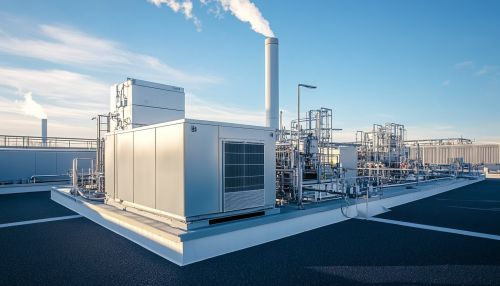Maximum Achievable Control Technology: Difference between revisions
No edit summary |
No edit summary |
||
| Line 27: | Line 27: | ||
The development of new and improved control technologies is a critical component of the MACT program. As technology advances, the EPA periodically reviews and updates MACT standards to reflect the latest innovations. This ensures that the standards remain effective in reducing emissions and protecting public health. | The development of new and improved control technologies is a critical component of the MACT program. As technology advances, the EPA periodically reviews and updates MACT standards to reflect the latest innovations. This ensures that the standards remain effective in reducing emissions and protecting public health. | ||
[[Image:Detail-99443.jpg|thumb|center|An industrial facility with emissions control equipment visible on the roof.]] | [[Image:Detail-99443.jpg|thumb|center|An industrial facility with emissions control equipment visible on the roof.|class=only_on_mobile]] | ||
[[Image:Detail-99444.jpg|thumb|center|An industrial facility with emissions control equipment visible on the roof.|class=only_on_desktop]] | |||
== Economic and Environmental Impact == | == Economic and Environmental Impact == | ||
Latest revision as of 03:00, 30 October 2024
Introduction
Maximum Achievable Control Technology (MACT) represents a regulatory standard used in the United States to control emissions of hazardous air pollutants (HAPs) from stationary sources. Established under the Clean Air Act Amendments of 1990, MACT standards are designed to reduce emissions of toxic air pollutants that pose significant risks to human health and the environment. The Environmental Protection Agency (EPA) is responsible for determining and enforcing these standards, which are based on the best-performing technologies and practices currently available.
Regulatory Framework
The Clean Air Act (CAA) is the primary federal law governing air pollution control in the United States. Under the CAA, the EPA is tasked with setting National Emission Standards for Hazardous Air Pollutants (NESHAPs) for major sources of air pollution. MACT standards are a subset of NESHAPs and apply to major sources, defined as facilities emitting 10 tons per year or more of a single HAP or 25 tons per year or more of a combination of HAPs.
Determination of MACT Standards
The process of determining MACT standards involves several steps. Initially, the EPA identifies the source categories and subcategories of emissions. Then, the agency conducts a thorough analysis of existing technologies and practices used to control emissions within these categories. The EPA considers the performance of the top 12 percent of existing sources, known as the "MACT floor," to establish a baseline for the standards. The agency may also consider more stringent measures, known as "beyond-the-floor" standards, if they are deemed achievable and cost-effective.
Implementation and Compliance
Once MACT standards are established, affected facilities must implement the necessary control technologies and practices to comply with the regulations. Compliance is typically required within three years of the standards being finalized, although extensions may be granted in certain circumstances. Facilities must demonstrate compliance through performance testing, monitoring, and reporting to the EPA.
Monitoring and Reporting
Facilities subject to MACT standards are required to conduct regular emissions monitoring to ensure compliance. This may involve continuous emissions monitoring systems (CEMS) or periodic stack testing, depending on the specific requirements of the standard. Facilities must also maintain detailed records and submit regular reports to the EPA, documenting their compliance status and any deviations from the standards.
Technological Considerations
MACT standards are based on the best-performing technologies and practices available at the time of their development. These technologies can vary significantly depending on the source category and the specific pollutants being controlled. Common control technologies include scrubbers, fabric filters, electrostatic precipitators, and activated carbon injection systems.
Advances in Control Technologies
The development of new and improved control technologies is a critical component of the MACT program. As technology advances, the EPA periodically reviews and updates MACT standards to reflect the latest innovations. This ensures that the standards remain effective in reducing emissions and protecting public health.


Economic and Environmental Impact
The implementation of MACT standards has significant economic and environmental implications. While the costs of installing and operating control technologies can be substantial, the benefits of reduced emissions and improved air quality are considerable. The EPA conducts cost-benefit analyses to assess the economic impact of proposed standards and to ensure that they are economically feasible for affected industries.
Health and Environmental Benefits
Reducing emissions of hazardous air pollutants has numerous health and environmental benefits. HAPs are known to cause a variety of serious health effects, including cancer, respiratory illnesses, and neurological disorders. By controlling emissions of these pollutants, MACT standards help to protect public health and improve air quality. Additionally, reducing HAP emissions can have positive effects on ecosystems and wildlife, as many of these pollutants are persistent and bioaccumulative.
Challenges and Criticisms
Despite the benefits of MACT standards, the program faces several challenges and criticisms. One of the primary challenges is the complexity and cost of implementing the required control technologies, particularly for smaller facilities. Additionally, some stakeholders argue that the standards do not go far enough in reducing emissions and protecting public health.
Legal and Political Challenges
MACT standards have been the subject of numerous legal challenges, with industry groups and environmental organizations often taking opposing positions. Industry groups may argue that the standards are overly stringent and economically burdensome, while environmental organizations may contend that the standards are insufficiently protective. These legal challenges can result in delays and modifications to the standards.
Future Directions
The future of MACT standards will likely be shaped by ongoing technological advancements, regulatory developments, and shifts in political priorities. As new control technologies become available, the EPA may revise existing standards to incorporate these innovations. Additionally, changes in the political landscape could influence the direction and scope of the MACT program.
Integration with Other Regulatory Programs
MACT standards are part of a broader regulatory framework aimed at reducing air pollution and protecting public health. The integration of MACT standards with other regulatory programs, such as the National Ambient Air Quality Standards (NAAQS) and the Greenhouse Gas (GHG) regulations, could enhance the overall effectiveness of air quality management efforts.
